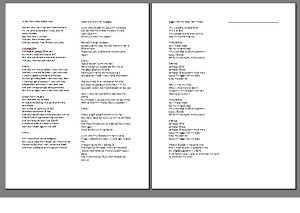Lyric Songwriting Intervention
As I write this post, internship is still very fresh in my mind. And one thing I definitely remember was the lack of internet resources for intervention ideas in general. Research articles can be difficult to translate into clinical practice and online searches turn up entire activity books, but not single interventions. One reason I write this blog is to fill in a little bit of the gap.
One of my first groups as an intern at NorthShore University HealthSystem’s Evanston Hospital was with the partial hospitalization psych program. These patients were at a higher level of functioning and came for group counseling for a several hours a day, many after being in an in-patient unit. Because they were able to process their feelings with greater depth, I knew lyrics analysis was a strong tool to use with them. But, I realized that this can be a passive activity and some patients might be disengaged just listening to music or if they didn’t feel like discussing with the entire group. How could I design an intervention that allowed people to engage and be successful on their own level?
Inspired by a conference presentation given by Ron Borczon, from Cal State Northridge, I created my a hybrid lyrics analysis and songwriting activity. I chose three songs of different moods and styles that spoke about getting through different challenges. I then created a worksheet with each song’s lyrics in its own column with a the fourth column blank:
 While listening to the songs I asked my patients to complete three tasks: find at least one challenge, find at least one solution or coping mechanism, and to underline any words or phrases in the lyrics that spoke to them. After each song, we discussed the group’s findings and discussed any other themes that arose. After listening to the three songs, the patients were asked to look back at the lyrics they had underlined and compile them into a song/poem they wrote in the blank column on the worksheet. I encouraged them to substitute words or add their own original lines as they felt comfortable. At the end of the group, time to share their compositions with the group was provided.
While listening to the songs I asked my patients to complete three tasks: find at least one challenge, find at least one solution or coping mechanism, and to underline any words or phrases in the lyrics that spoke to them. After each song, we discussed the group’s findings and discussed any other themes that arose. After listening to the three songs, the patients were asked to look back at the lyrics they had underlined and compile them into a song/poem they wrote in the blank column on the worksheet. I encouraged them to substitute words or add their own original lines as they felt comfortable. At the end of the group, time to share their compositions with the group was provided.
I’ve gotten really good responses to this activity because it provides a good balance between structure and freedom. Patients have taken the songwriting portion really seriously and I’m always blown away by how heartfelt the sharing part of the group is. A great part is that you can customize the song groupings to be about different themes such as control, relationships, support systems, etc. Below is a list of songs I’ve used in the past, but the sky is the limit on this one!
Breathe (2AM) by Anna Nalick
In Your Own Way by Caleb Kane
Bigger Than My Body by John Mayer
Control by JJ Heller
Drive by Incubus
Dark Side by Kelly Clarkson
So, in summary this activity requires writing utensils, worksheets, and recordings of three songs. Hope this intervention can be a springboard for your own groups and feel free to comment with adaptations or other ideas!
The above intervention was designed by the writer from her experiences and knowledge of music therapy practice. Any similarity to copyrighted material is unintentional.